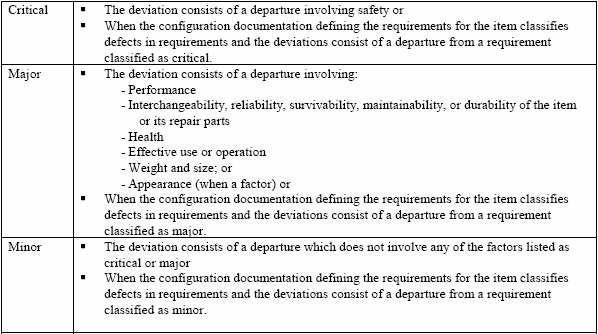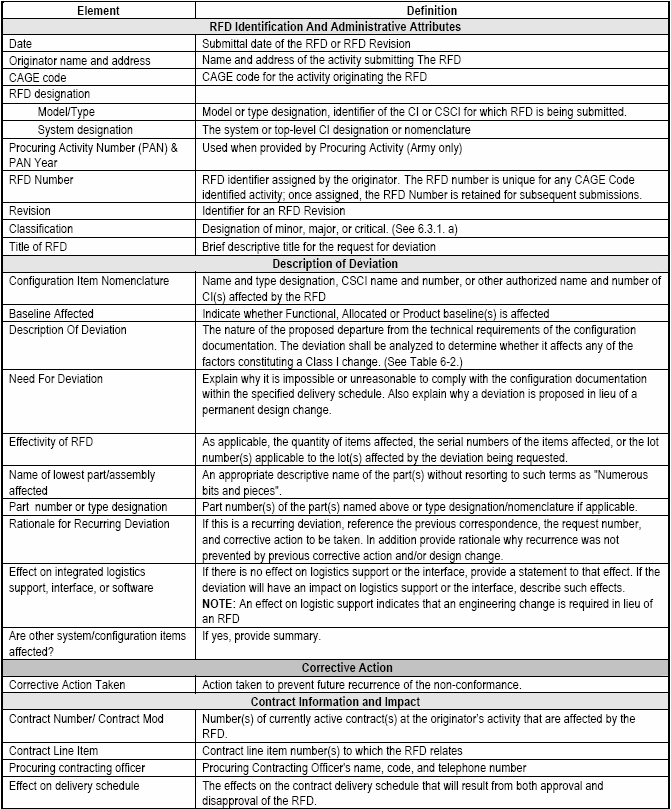MIL-HDBK-61A: Configuration Control
< Previous | Contents | Next >
6.3 Request for Deviation
A deviation is a specific written authorization to depart from a particular requirement(s) of an item's current approved configuration documentation for a specific number of units or a specified period of time. It differs from an engineering change since a deviation does not effect a change to a configuration document.
Deviations are requested by contractors prior to manufacture, during manufacture, or after an item has been submitted for Government inspection and acceptance.To be tendered for delivery or to be installed in an item to be tendered for delivery, the deviant item must be suitable for use.
Requests for Deviation (RFDs) are most often used for production CIs delivered as a part of a production contract. They are typically associated with current, or future, delivery of items that do not, or will not, conform to the Government-baselined configuration documentation. An RFD is submitted, if during design and development, the contractor determines that for a valid reason (such as long lead time) a Government required performance attribute will not be met or verified before scheduled delivery of a limited number of production units. An RFD is also submitted when prior to the beginning of the final assembly of the first affected serial-numbered unit of a CI, the contractor finds it necessary to deliver one or more parts in a configuration other than that described by the item's baselined documentation. RFDs must pertain only to the technical requirements of a CI and not the bulk materials used in manufacture.
a. RFD Classification.
RFDs are classified by their originators as either Minor, Major or Critical, unless the contract specifies that a government's technical representative is responsible for assigning the classification. The classification designations, which match the corresponding classification of characteristics specified in MIL-STD-2101, are as follows:

b. RFD effectivity.
RFD effectivity is the means used by the originator to specifically designate each separate unit (or lot of units) of the CIs that are known to be, or that will be, impacted by a proposed RFD. All units impacted by an RFD must be identified by serial number, lot number, or similar identifier that allows identification of affected units.
c. RFD preparation and submittal.
RFDs are prepared and submitted to the government in accordance with the configuration management requirements of the applicable contract including the CDRL/DD Form 1423 citing the latest approved DID for RFDs. RFDs must be approved or disapproved based on the merits of the initial submittal. However, changes to a previously submitted RFD not yet approved, may be addressed as a revision to the initial RFD number.
If the Government has established a Government CM AIS system for the program, the data requirement for RFDs should request either digital submittal of RFD data, population of the DoD database directly by the contractor, or access to the RFD via the World Wide Web. All RFD fields of information are defined in the EIA Standard 836 data dictionary and its related XML ECP Business Object. [Detail: Activity Guide: Table 6-9]
d. RFD approval/disapproval decisions.
A Critical RFD should not approved by the Government except under the most extenuating circumstances; and with the approval of the Activity's Commanding Officer. Critical RFDs involve a departure from requirements that have a profound impact on safety. They affect operational capabilities (including service life) of a CI, and its logistics supportability. It is therefore considered unacceptable to authorize the manufacture of a CI incorporating a Critical RFD.
Major RFDs (and critical RFD's subject to limitations expressed above) must be approved or disapproved after careful review and consideration by a government CCB. Once approved, additional government actions or authorizations may still be required. An approved RFD will normally require a formal contract modification or an approval letter signed by the government CO.
RFDs are normally processed for benefit of the contractor, since the government wants the contractually specified configuration. The FAR (46.407) specifies that the government normally should accept "non-conforming material" only when it is in the Government's best interests, and there is appropriate consideration. Therefore, if the RFD is approved, it is imperative that the government contracting officer negotiate an equitable consideration from the contractor based on either (or both) the quantity of CIs affected by the RFD or the extent the affected CIs do not meet the government's contractual requirements. Based on the CCB review, the appropriate consideration to the government resulting from RFD approval should be estimated and furnished to the contracting office for negotiation.
When major and critical RFDs are disapproved, all that is normally required is a disapproval letter signed by the CO or other government representative identified in the contract. An RFD disapproval letter should state the reason(s) for disapproval.
Minor RFDs are normally approved by the government CAO or other representative identified in the contract. In the case of minor RFD occurring during manufacture, minor RFDs are normally approved or disapproved by a properly constituted Material Review Board (MRB) [MIL-STD-1520]. In the absence of a MRB, approval or disapproval will be made by either the government ACO or technical representative identified in the contract. In most instances, the approval or disapproval of minor RFDs, due to their simplistic nature, is not considered significant enough to require subsequent government action or authorization.
In a performance based acquisition, where the Government has not established a product baseline, minor deviations to Government approved configuration documentation should be extremely rare; most if not all should impact only contractor controlled configuration documentation and should be dispositioned using the contractors material review process.
CIs tendered for delivery with either approved Government or contractor RFDs must be suitable for their intended use without requiring subsequent repair or restoration at government expense.
e. Recurring RFDs.
A recurring RFD is a repetition or extension of a previously approved RFD that applies to the same CI and contractor. Where a contractor experiences the same situation for the first time on more than one CI, each experience must be treated as a first time occurrence. Likewise, if multiple contractors experience the same situation for the first time, it must also be treated as a first time occurrence under each applicable contract.
Action should be taken by the government to ensure that approved RFDs are rarely submitted on a recurring basis. Recurring RFDs should trigger government concern that either corrective manufacturing action needs to be implemented by the contractor or that the CI's technical requirements may be too stringent. In the case of the latter, the government should request a Class I ECP from the contractor for revising the CI's current technical documentation.
RFDs are prepared and submitted to the government in accordance with the configuration requirements of the applicable contract SOW and CDRL/DD Form 1423
The following Activity Guide [Table 6-9], delineates the data content of an RFD.
Table 6-9. Activity Guide: RFD Content


A deviation requested during or after manufacture was formerly called a waiver. However, the processing rules for a request for waiver are identical to those for a deviation, and the terms deviation and waiver where often confused. The DoD will no longer maintain the redundant processing, forms or data fields, and instructions.
For correct application of this information, see NOTE on Contents page